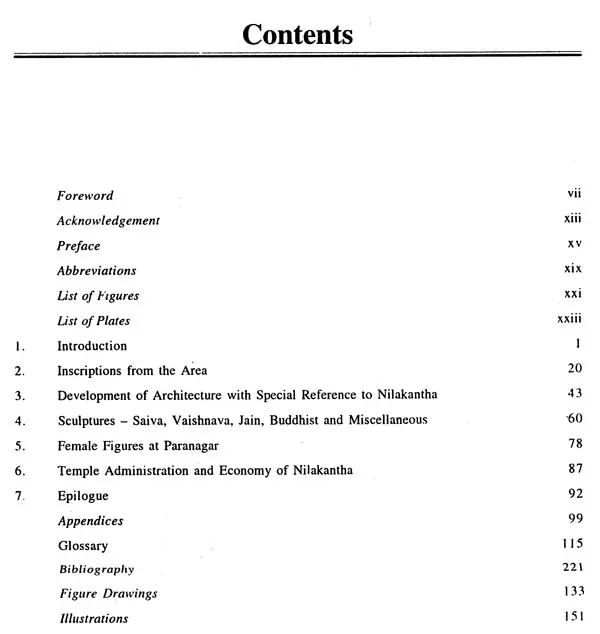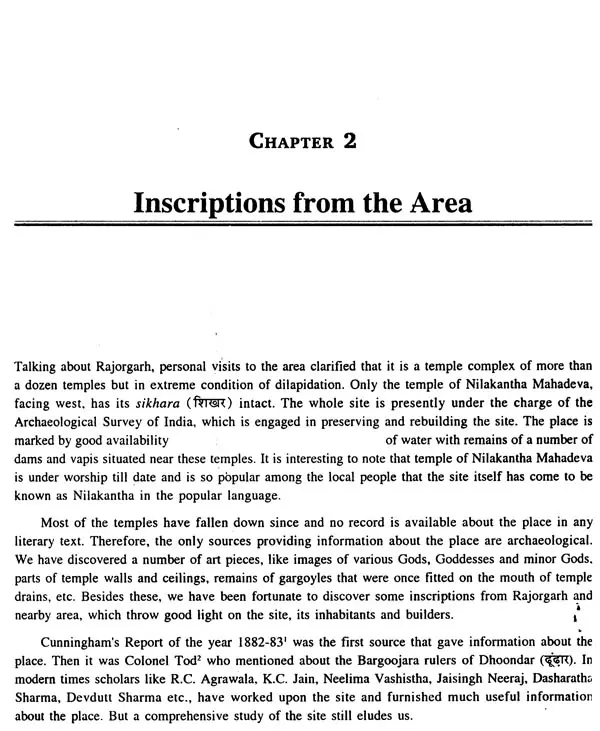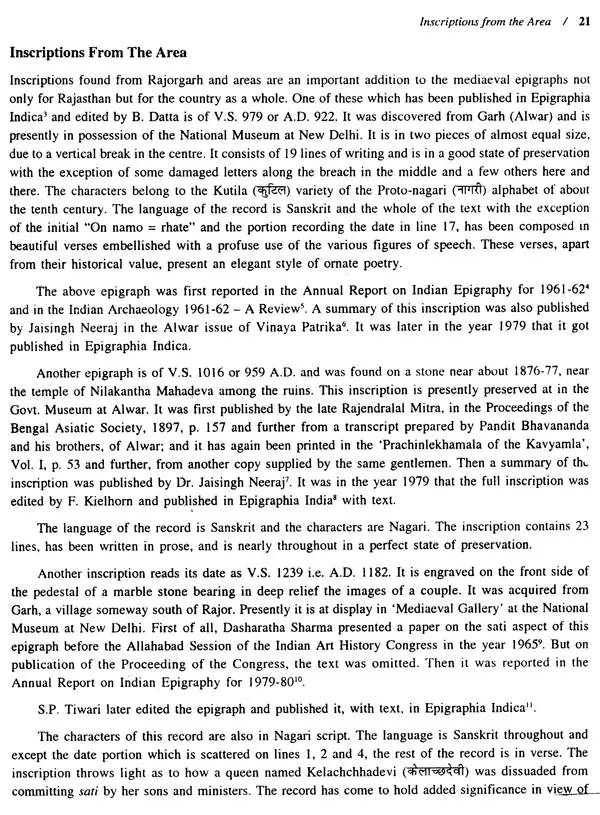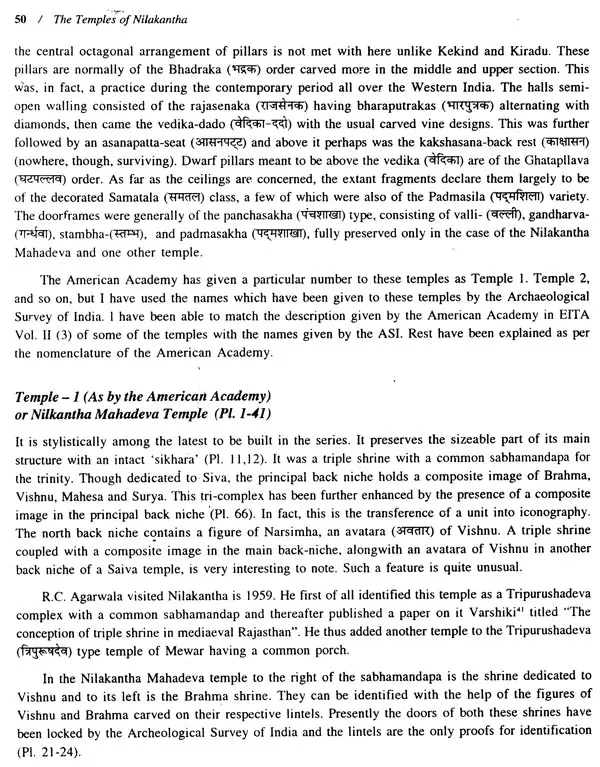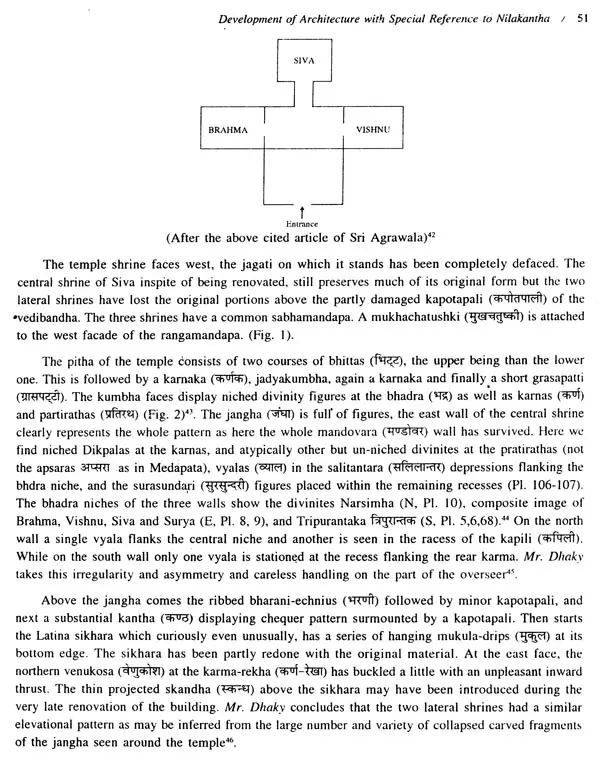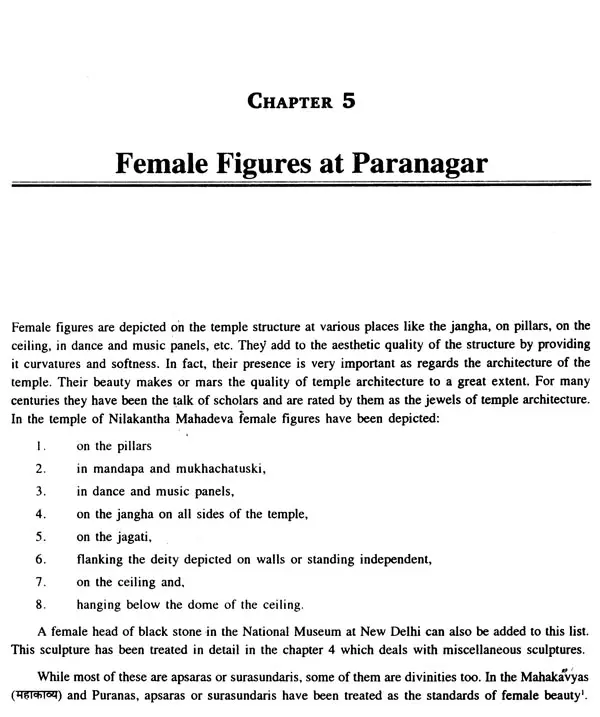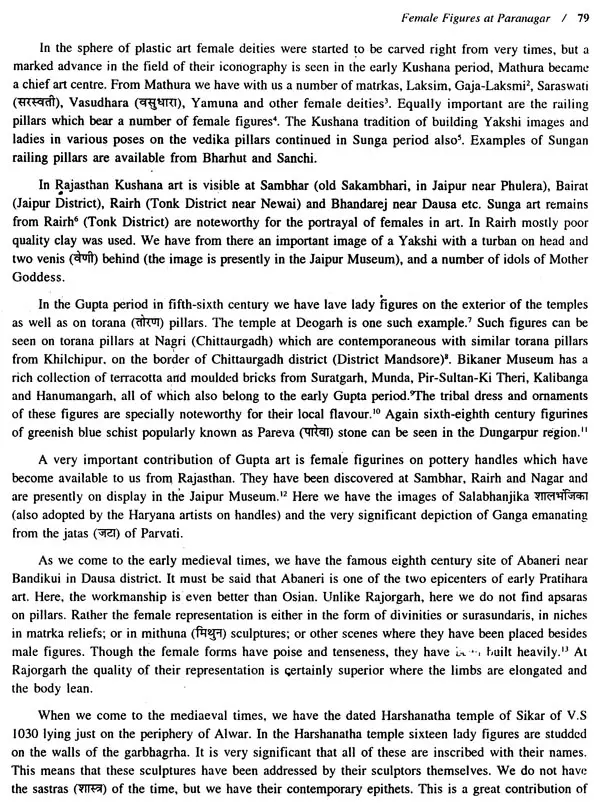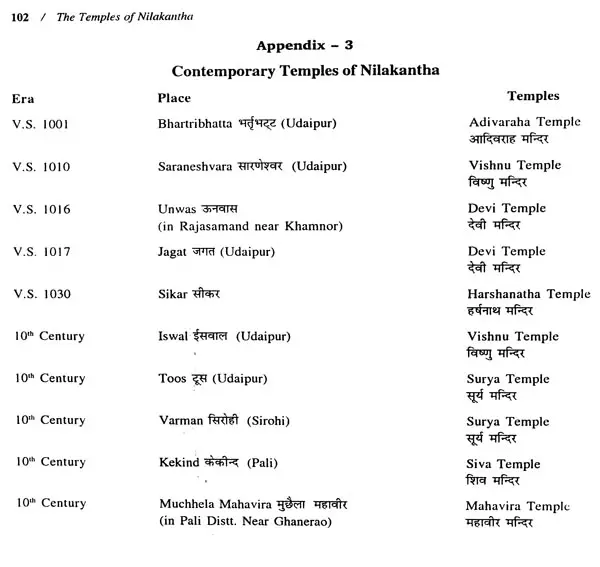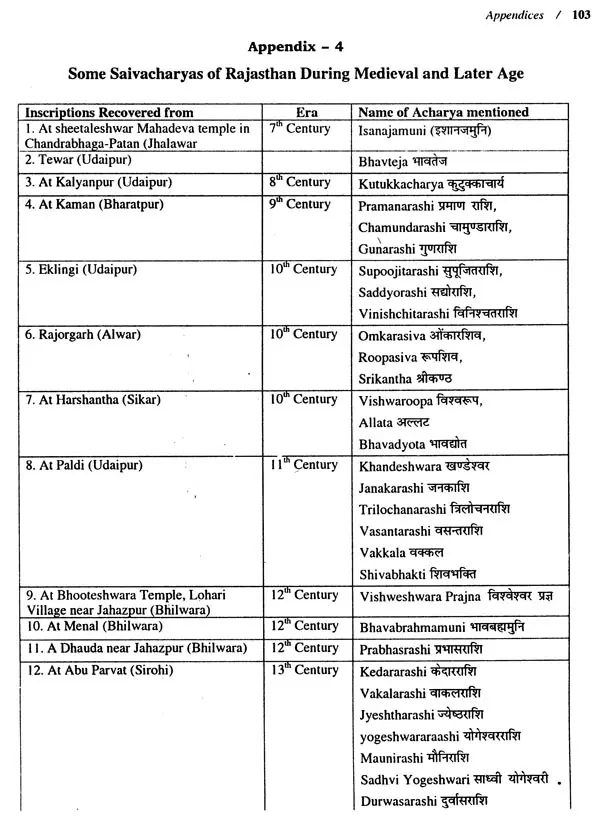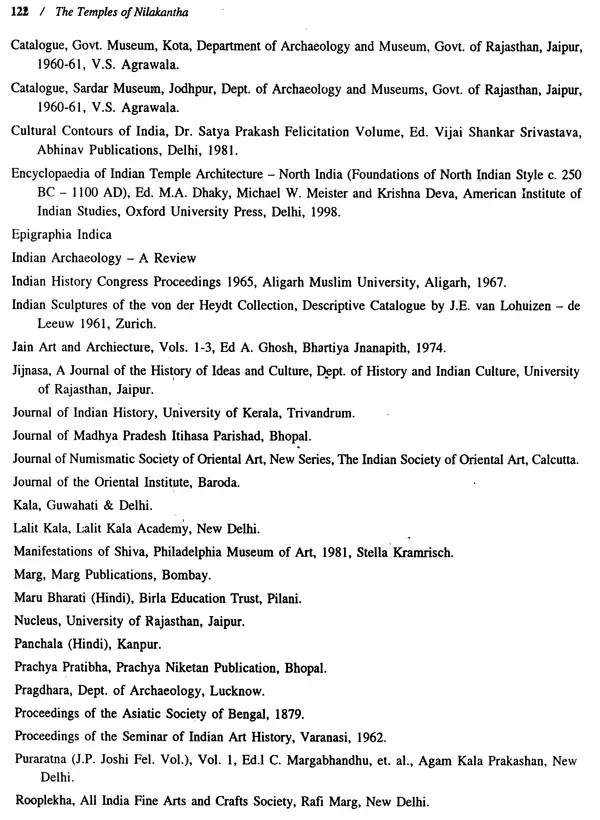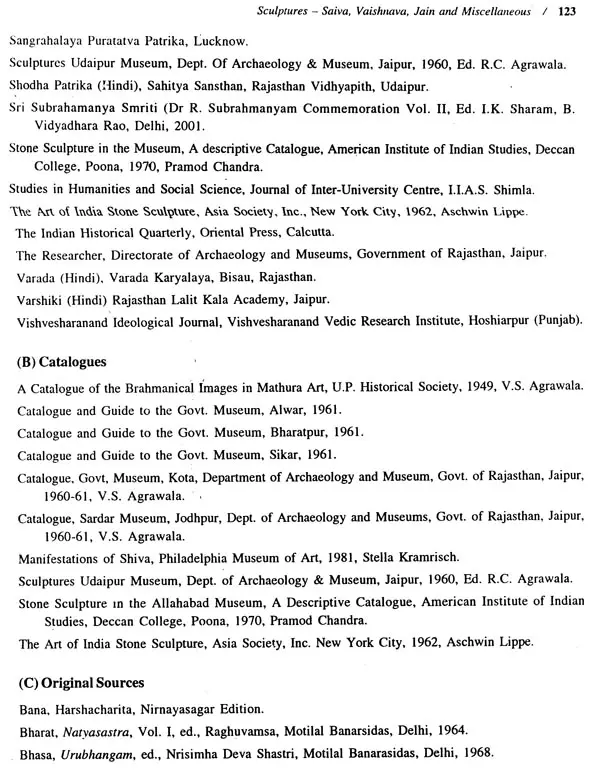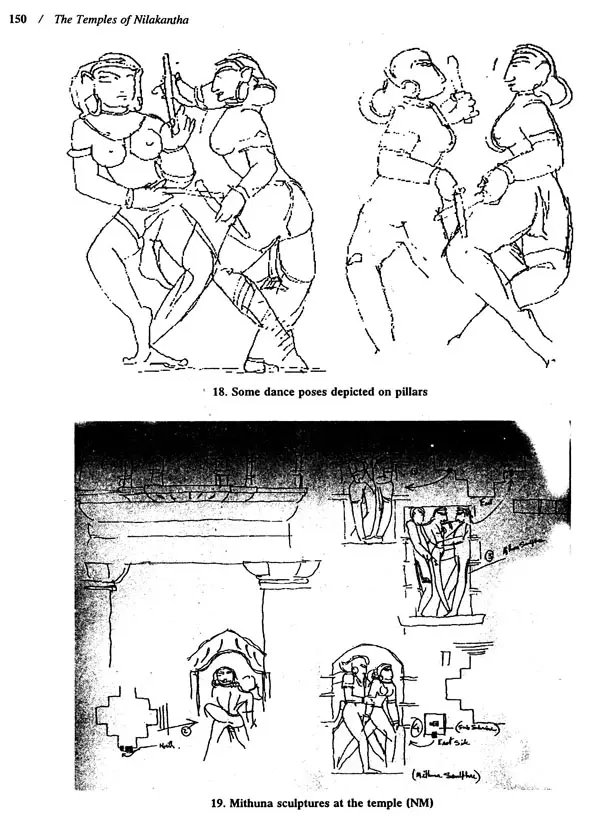
The Temples of Nilakantha Rajasthan- A Critical Study
Book Specification
| Item Code: | UAE280 |
| Author: | Meeta Garg |
| Publisher: | Literary Circle, Jaipur |
| Language: | English |
| Edition: | 2012 |
| ISBN: | 9789381951118 |
| Pages: | 208 (Throughout B/w Illustrations) |
| Cover: | HARDCOVER |
| Other Details | 11.00 X 9.00 inch |
| Weight | 790 gm |
Book Description
While the circular bricks structure is believed to be the ruins of one of the earliest specimens of temple architecture, the traces of Buddhist monasteries all around, coupled with the evidence of inscriptions, suggest that Bairat had a large settlement of Buddhist monks and nuns. Lalsot and Rairh near Jaipur, similarly, were other centres of Buddhism in Rajasthan. So were Chittor and Nagari in the region of Medapata (Mewar). Buddhism seems to have received a set-back in Rajasthan with the influx of martial races, e.g. Malavas, Yaudheyas, Sibis, Abhiras et al from the Punjab under the pressure of Greek onslaughts. Brahmanical religion and sacrifices, which had deeper roots in the society began to be popular' once again. The erection of numerous yupa pillars in the early centuries of the Christian era testify to therevival of Vedic sacrificial cult. The resurgence of Brahmanical faiths in Rajasthan is evidenced by the beautiful sculptures from Amjhara in Dungarpur, Jagat in Udaipur, Abaneri in Dausa, Osia in Jodhpur, Baroli ,in Kota belonging to the Gupta and later Gupta periods.
The broad circuit formed by Alwar and Dausa districts is dotted with some rich archaeological and architectural sites, the important ones being Neelkantha, Abaneri, Bhangarh, Narayani Mata, Tasai, Talvriksha, Khuntet, Talab, Macheri, Khoh etc. The key landmark of this circuit is the wide expanse of the Aravalli hills which generally open to the north and east. Almost uninterrupted ranges on the western side run for about 80 kilometers. A distinguishing feature of the Aravallis in this area is the formation of sheltered valleys, with regular streams of water, secluded by lofty hills and thick blanket of wild vegetation, providing natural cover, ideal for large human settlements. The rich geological formations are comprised of granites, quartzites, limestones, phylites slates, pegmatites, schists etc. Abundant copper and iron ore formations in several localities also seem to have aided and abetted the early growth of settlements.
Regional history has assumed great importance since the early decades of the last century. Its knowledge is of significant use to both academics as well as people at large of the respective regions. Its real utility lies not in its appeal to parochial sentiments, but in its vast potential for micro level studies. Fortunately, the historical and archaeological material available in Rajasthan is exceptionally rich. The discovery and identification of antiquities and records not only enable us to give life and flesh to events, objects and their authors, but they also enable us to reconstruct the institutional structure of religious, social and political life of the people in this region. Lot of intensive work has, no doubt, been done by eminent scholars unraveling different facets of its history and culture, yet much more exhaustive work, especially in the field of archaeology and art, still remains an urgent desideratum. As regards the study of plastic arts, Rajasthan is an extremely promising land, though it has largely remained a terra incognita so far. Many temples and images still lie unnoticed in remote and inaccessible areas. Quite a good number of monuments appear to have been destroyed by the ravages of nature and man. But those preserved give an impression that art and architecture of Rajasthan, reflecting a cultural continuity from the Gupta age to 15th century, reached a stage of culmination in the famous 'Victory Tower' of Chittor, which, according to scholars, is nothing but the whole world manifested, 'darshita - vishava - rupa' and its detailed analysis could itself constitute an encylopaedic commentary on 'the culture of the times. While the Rajasthan State Department of Archaeology, and the Archaeological Survey of India have done commendable job over the years to highlight and preserve its art and antiquities, wider involvement of Ph.D. and M. Phil students to undertake their rigorous and minute studies will contribute not only to greater awareness about our cultural heritage but will also help in safeguarding the invaluable monuments from disappearing silently.
Their works include:
Encyclopedia of Indian Temple Architecture - North India (Foundations of North Indian Style c. 250 B.C. - 1100 A.D.), Ed. M.A. Dnaky, Michael W. Meister, and Krishna Deva, American Institute of Indian Studies, Oxford University Press, Delhi, 1998.
Neelima Vashishta, Rajasthan ki Murtikala Parampara (Hindi), Rajasthan Hindi Granth.Academy, Jaipur, 2001.
Neelima Vashishtha, Sculptural Traditions of Rajasthan (c. 800 - 1000 A.D.), Publication Scheme, Jaipur, 1989.
K.C Jain, Ancient Cities and Towns of Rajasthan - A Study of Culture and Civilization, Motilal Banarsidas, Delhi.
K.C Jain, Jainism in Rajasthan, Jaina Samskriti Samrakshika Sangha, Sholapur, 1963.
Devdutt Sharma, "Prastara Pratimaon ka Utkeerna Grantha: Nilakantha", Akriti (Hindi), Rajasthan Lalit Kala Academy, Jaipur, July-Sept. 1966, pp. 30-33.
R.C ..Agrawala, "Some Composite Sculptures from Rajasthan", The Researcher, Vol. II, DAM, Govt. of Rajasthan, Jaipur, pp. 16-22.
R.C Agrawala, "The Conception of Triple Shrine in Mediaeval Rajasthan", Varshiki, Rajasthan Lalit Kala Academy, Jaipur, 1963, p. 49.
R.C Agrawala, "Prachina Rajasthana Ke Saiva Acharya Evam Saiva Matha", Varda (Hindi), Varsha 8, Anka I, Bisau, January 1965, pp. 1-13.
Numerous other articles of R.C Agrawala and other scholars on the contemporary sites which help in comparative study.
Yet all these present only are aspect of the site. If one deals with architecture, other deals with sculptures from the site and only a few of the sculptures have been discussed in detail. A comprehensive study remains to be done. Moreover, the socio-economic life delineated from sculptures and epigraphs from the area, its administration and its people have not been talked about.
In my work I have tried to cover not only the sculptures and architecture of the site, but also compared them with the contemporary material from nearby regions. The location and hydrology of the site have been reported in detail and the socio-economic aspect has been covered as well. On the basis of epigraphs available to us, from the region, we have tried to delineate administration of the region. Few such sculptures have been included in the work which had been unpublished till date. In Chapter 1 the location, hydrology, people, crop system, etc. of the area has been talked about in order to give a complete introduction of the region. Early history of the place, its rulers, and financial position of their kingdom has been discussed.
The area nearby Rajorgarh is .very rich culturally. Bordering is the 8th century site of Abaneri (~), 9th century site of Narayani Mata and V.S. 1030 Harshatmata (6$n~ temple at Sikar. We have also other important site of Tasai, Talvriksha, Khuntet, Talab, Macheri, Bhangarh, Khoh, etc. where we have found important inscriptions and art remains. Kaman, another Pratihara site of 8th - 9th century is also located nearby. Thus, it can be said that the place did not develop in a vaccum.
Paranagar is a tenth century site of more than a dozen temples mostly in ruins. Only the temple of Nilakantha Mahadeva facing west, has its sikhara (~ intact. The whole site has been taken over by the Archaeological Survey of India (ASl) and the temple of Nilakantha Mahadeva has been declared a National Monument. The temple is under worship till date and the site itself has come to be known as Nilakantha in the popular language after it.
The site in surrounded by forests and except for a few fields, not much habitation can be seen nearby. Hundreds of sculptures have been discovered at the site and numerous others still lie about the place. Until a few years back this whole treasure was lying scattered and unguarded. So a number of sculptures have been stolen from there. Now, a police out post has been put up at the site itself. The A.S.I. too has posted some guards -there. Even the Pujari of Nilakantha temple is an appointee of the A.S.I.
As we go from Rajgarh to Nilkantha via Talab and Tahla, the distance from Rajgarh to Talab is 21 kilometers and from Talab to Tabla it is another 5 kilometers. From Tabla the distance upto Nilakantha is further 10 kms. Out of this 10 kms stretch, the last 3 to 4 kms distance is a zigzag narrow ascending road, some part of which is steep high. Hence, the place becomes comfortably approachable by jeep only. However, the local people from the surrounding village walk upto the Nilakantha temple.
Another way to approach Paranagar is from Dausa, but the way itself and the means available from Rajgarh, are comparatively better.
Hydrology
Water plays a great part in the religious life of a Hindu. It is needed for ablutions and for offering water to God. Since the site was a prominent Saiva center, the availability of water was all the more important as bathing the Siva-linga with water is an essential requisite of Saiva worship'.
The site of Nilakantha was also abundantly supplied with water. A number of 'Deoris' ~ had been built near the place (PI. 59), one of which was attached to a temple there known as Bagh-ki-deori. One was also attached to the Jain temple at the site. A pond has been found near a temple named Lachhuwa-ki-deori. A number of dams were situated near about the site, such as Mallana Dam within Tahla panchayat, Manglasar Dam between Tahla and Talab, Mansarover between Nilakantha and Tahla, Ramkund about 1 km south-east of Nilakanth temple in which rain water coming down from the surrounding hills gets stored up. Jahaz an area in Talab panchayat amidst hills is a place where rain water gets collected and then falls in the form of a waterfall. All the water from the- hills goes into Mallana Dam and when this over flows it goes to Rediya Dam in Dausa District", It must be noted here that Talab itself is a village inhabited around a huge talab i.e. a big pond. A number of dams and ponds near the site, testify the fact that during rains a number of seasonal streams flow about the place.
About six to seven kilometers from Nilakantha Mahadeva is the Kankwadi Fort where Raja Jaisingh! used to keep prisoners punished with transportation for life. There a dam also exists.' The local people also informed me that near Bharthari (between Alwar and Pandupole) there is a place called Natni-ka-bara From here a perennial river flows. Jai Singh divided the water of this river, sending one half to Jaisamand Dam and another half to Bharatpur.
People
The villages of Rajor and Garh are mostly inhabited by people of Meena and Gujar ("TR) tribes.
They domesticate goats, buffaloes and some camels also. For Kharif they harvest mustard and for Rabi they harvest wheat, gram and corn.
Talab and Tahla on the other hand are inhabited mostly by Brahmana. In Talab, Meenas came second in strength after Brahmana. Rest of the people belong to Koli Balai, Rana, Mahajana and Vijaivargiya castes. They domesticate buffaloes. goats, camels and some cows also They sow corn, bajra and jowar for Kharif season and mustard, gram, wheat and barley for Rabi.
At Tahla, in numbers second place is held by Gujar, Bairwa and other caste people. Like the above too places, here also, people engage in agriculture and domestication animals.
Book's Contents and Sample Pages
